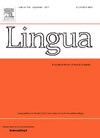接触驱动句法变化中的母语迁移和输入需求
IF 1.3
3区 文学
0 LANGUAGE & LINGUISTICS
引用次数: 0
摘要
新英语的研究经常通过比较两种语言系统来检验基于接触的变化,看看基底语言的特征x是否出现在接触变化中。在本文中,我将说明这种方法是不完整的。通过观察印度英语使用者的双语群,我发现只有一些基本特征在整个人口中稳定下来,而在新加坡英语中,相同特征的不同子集稳定下来了。单靠母语迁移无法解释这种差异;它过度预测变化。我将重点放在后殖民英语的一个不同特征上——原始殖民英语变体的输入减少——并表明需要进一步的因素,输入需求:在特定L1的情况下,获得L2语法形式所需的输入量。这两个因素的相对强度然后在句法变化的四种类型中进行评估。两者都有助于长期稳定的结果,但基质类型有时似乎对可学习性方面施加了严格的限制,而不管输入如何。本研究证明了第二语言习得理论中的关键构式对研究长期接触驱动的语言变化的重要性。本文章由计算机程序翻译,如有差异,请以英文原文为准。
L1 transfer and input demand in contact-driven syntactic change
Studies of New Englishes often examine contact-based change by comparing the two language systems involved, to see if feature x from the substrate language appears in the contact variety. In this article I show that this approach is incomplete. Looking across a bilingual cline of Indian English speakers, I show that only some substrate features have stabilized across the whole population, and that a different subset of the same features has stabilized in Singapore English. L1 transfer alone cannot account for this difference; it over-predicts change. I focus on a different hallmark of postcolonial Englishes—diminishing input from the original colonial English variety—and show the need for a further factor, input demand: the amount of input needed to acquire an L2 syntactic form given a specific L1. The relative strength of the two factors is then assessed in a four-way typology of syntactic changes. Both are instrumental in long-term stable outcomes, but substrate type appears to sometimes place hard limits on aspects of learnability regardless of input. The study demonstrates the importance of key constructs in Second Language Acquisition theory for the study of long-term contact-driven language change.
求助全文
通过发布文献求助,成功后即可免费获取论文全文。
去求助
来源期刊

Lingua
Multiple-
CiteScore
2.50
自引率
9.10%
发文量
93
审稿时长
24 weeks
期刊介绍:
Lingua publishes papers of any length, if justified, as well as review articles surveying developments in the various fields of linguistics, and occasional discussions. A considerable number of pages in each issue are devoted to critical book reviews. Lingua also publishes Lingua Franca articles consisting of provocative exchanges expressing strong opinions on central topics in linguistics; The Decade In articles which are educational articles offering the nonspecialist linguist an overview of a given area of study; and Taking up the Gauntlet special issues composed of a set number of papers examining one set of data and exploring whose theory offers the most insight with a minimal set of assumptions and a maximum of arguments.
 求助内容:
求助内容: 应助结果提醒方式:
应助结果提醒方式:


